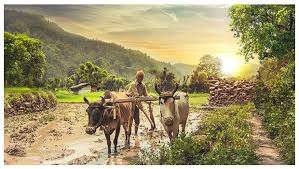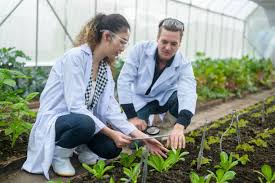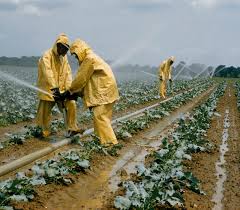Agriculture is a vital industry that plays a central role in sustaining human civilization. It involves cultivating soil, growing crops, and raising animals to produce food, fiber, medicinal plants, and other products necessary for human life. Agriculture has not only provided food but has also been instrumental in economic development, cultural evolution, and societal growth.
Agriculture is the practice of cultivating plants and livestock to produce food, fiber, fuel, medicinal plants, and other goods that sustain and enhance human life. It encompasses various activities, including soil cultivation, crop production, animal husbandry, and agroforestry.
Historical Background of Agriculture
Agriculture began around 10,000 years ago during the Neolithic Revolution, when humans transitioned from hunting and gathering to settled farming. Early agricultural societies emerged in the Fertile Crescent, including present-day Iraq, Egypt, and parts of Syria and Turkey.
This shift allowed for more stable food supplies, leading to the development of complex societies, technological advancements, and urbanization. Over time, agriculture spread worldwide, adopting new techniques and crops as it adapted to different climates and regions.
Types of Agriculture
Agriculture can be classified into various types based on methods, scale, and purpose. The primary types include:
1. Subsistence Agriculture: Involves small-scale farming primarily for personal or family consumption. It is prevalent in developing regions and is focused on meeting the immediate needs of the farmer.
2. Commercial Agriculture: Involves large-scale farming primarily for profit. It includes the production of cash crops such as wheat, corn, and soybeans, often using advanced technology and mechanization to increase efficiency and output.
3. Organic Agriculture: Focuses on growing crops and raising livestock without synthetic chemicals, relying on natural methods for pest control, fertilization, and soil health. It is aimed at promoting ecological balance and biodiversity.
4. Industrial Agriculture: Characterized by high-input, high-output practices, including the use of machinery, fertilizers, and pesticides, aimed at maximizing production. This type of agriculture is common in developed countries and large-scale farms.
5. Agroforestry: Combines trees and shrubs with crops or livestock, creating a more diverse, productive, and sustainable agricultural system that supports biodiversity and improves soil health.
6. Aquaculture: The farming of fish, shellfish, and other aquatic organisms for food, which provides an alternative to wild-caught fish and helps meet the growing demand for seafood.
Importance of Agriculture in Society

Agriculture is fundamental to society for several reasons:
1. Food Supply: Agriculture is the primary source of food, providing grains, fruits, vegetables, meat, dairy, and other essential products for human nutrition.
2. Economic Development: Agriculture contributes to the GDP of many countries, providing jobs and supporting industries such as food processing, transportation, and retail.
3. Cultural Significance: Agricultural practices are deeply rooted in traditions and play an essential role in cultural identity, with certain crops and farming techniques defining regions and societies.
4. Environmental Impact: Sustainable agricultural practices help preserve natural resources, promote biodiversity, and mitigate climate change by sequestering carbon and reducing emissions.
5. Rural Development: Agriculture is a cornerstone of rural communities, supporting livelihoods, enhancing local economies, and fostering community well-being.
6. Resource Management: Agriculture involves the careful management of soil, water, and other natural resources, encouraging sustainable practices that help protect ecosystems and ensure resources are available for future generations.
Economic Importance of Agriculture
Agriculture significantly contributes to economies worldwide, especially in developing countries. It drives job creation, supports related industries, and fuels international trade. Key aspects of agriculture’s economic role include:
1. Employment Opportunities: Agriculture provides livelihoods for billions of people globally, from small-scale farmers to workers in food processing and distribution.
2. GDP Contribution: In many countries, agriculture is a substantial part of the Gross Domestic Product (GDP), especially in regions where a large portion of the population relies on farming as their primary source of income.
3. Trade and Export: Agricultural products are major exports for many countries, contributing to foreign exchange earnings. Commodities such as coffee, cocoa, grains, and cotton are crucial in global trade.
4. Rural Development: Agriculture supports rural economies, improving living standards and infrastructure in these areas and encouraging community development.
5. Supporting Industries: Agriculture drives demand for products and services from other sectors, such as machinery, chemicals, transportation, and finance, thereby supporting industrial and service sector growth.
Read Also: Balloon Flowers (Platycodon grandiflorus): All You Need to Know About
Agriculture and Food Security

Agriculture is essential for ensuring food security, especially as the global population grows. Sustainable farming practices are key to producing enough nutritious food to meet demand. Important aspects include:
1. Food Supply: Agriculture is the primary source of food, providing the calories and nutrients necessary for healthy human life.
2. Nutritional Diversity: Agricultural diversity helps ensure a wide range of foods, from grains and vegetables to meat and dairy, meeting various dietary needs.
3. Resilience to Crises: By supporting local food production, agriculture can help communities become more resilient to disruptions in global supply chains, natural disasters, or economic crises.
4. Poverty Reduction: Access to agricultural employment and income helps reduce poverty, which is closely linked to food insecurity.
5. Innovation for Sustainability: New agricultural technologies, like drought-resistant crops and precision farming, help increase yields and ensure sustainable food production.
Read Also: Azalea Flowers (Rhododendron spp): All You Need to Know About
Environmental Role of Agriculture

Agriculture interacts with the environment in numerous ways, both positively and negatively. It is vital for ecosystem services and biodiversity but must be managed sustainably. Key roles include:
1. Carbon Sequestration: Crops and trees absorb carbon dioxide, helping mitigate climate change and reduce greenhouse gases.
2. Soil Health: Through practices like crop rotation, cover cropping, and composting, agriculture can enhance soil fertility, support biodiversity, and prevent erosion.
3. Water Cycle Support: Agricultural plants help regulate the water cycle by absorbing and filtering water, which is crucial for maintaining local ecosystems.
4. Habitat for Wildlife: Farmlands, especially those managed sustainably, provide habitat for numerous species, including pollinators essential for crop production.
5. Conservation Practices: Sustainable agriculture includes practices like no-till farming, organic agriculture, and agroforestry that help protect and restore natural ecosystems.
Social and Cultural Significance of Agriculture
Agriculture has profound social and cultural importance. It shapes identities, fosters community, and preserves traditions. Key elements include:
1. Cultural Heritage: Agricultural practices and crops are often linked to cultural identities, regional cuisines, and traditional practices passed down through generations.
2. Community Building: Farming fosters community bonds through shared work, resources, and social activities, strengthening local ties and social cohesion.
3. Traditional Knowledge: Many agricultural practices are rooted in Indigenous knowledge, which includes valuable insights into sustainable farming techniques and biodiversity.
4. Seasonal Celebrations: Many cultures celebrate agricultural events, such as harvest festivals, reflecting the connection between agriculture and cultural expression.
5. Connection to Nature: Agriculture promotes a connection to the land, instilling a sense of stewardship and responsibility for natural resources.
Challenges in Modern Agriculture
Despite its importance, agriculture faces numerous challenges that threaten its sustainability and productivity. These challenges include:
1. Climate Change: Unpredictable weather patterns, extreme temperatures, and natural disasters impact crop yields, soil health, and water availability.
2. Resource Depletion: Intensive farming can lead to soil degradation, water scarcity, and biodiversity loss, undermining long-term productivity.
3. Economic Pressures: Small-scale farmers often struggle with high costs, fluctuating market prices, and lack of access to credit, making it difficult to invest in sustainable practices.
4. Pests and Diseases: Outbreaks of pests and diseases can devastate crops and livestock, leading to food shortages and economic losses.
5. Food Safety and Quality: Ensuring the safety and nutritional quality of food is critical, yet issues like contamination, chemical use, and antibiotic resistance pose ongoing risks.
6. Labor Shortages: In many regions, agriculture faces labor shortages due to migration, aging populations, and the physical demands of farming work.
Do you have any questions, suggestions, or contributions? If so, please feel free to use the comment box below to share your thoughts. We also encourage you to kindly share this information with others who might benefit from it. Since we can’t reach everyone at once, we truly appreciate your help in spreading the word. Thank you so much for your support and for sharing!
Read Also: How To Raise Chickens – The Simple Secrets To A Great Backyard Flock

